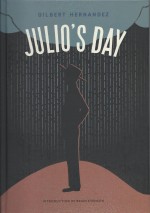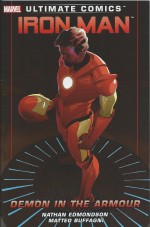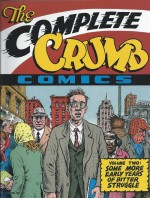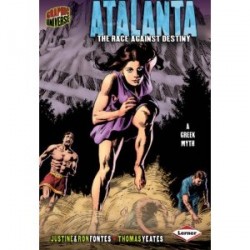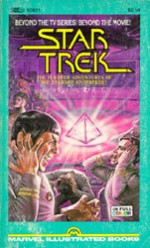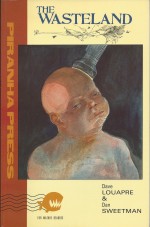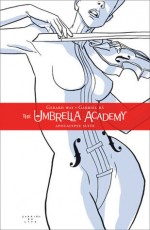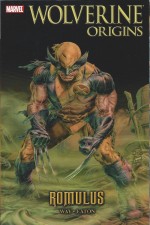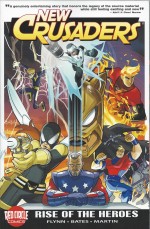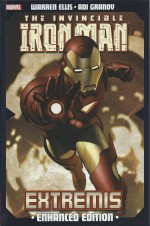
By Warren Ellis & Adi Granov (Marvel/Panini UK)
ISBN: 978-1-84653-527-7
Arch-technocrat and supreme survivor Tony Stark has played many roles in the Marvel Universe since his debut in Tales of Suspense #39 (March 1963) when, as visitor to an East Asian war-zone, he was critically wounded and captured by sinister, cruel Communists. Put to work building weapons with the dubious promise of medical assistance on completion, Stark instead created the first Iron Man suit to keep himself alive and deliver him from his oppressors.
Since then the inventor and armaments manufacturer became a liberal capitalist, eco-pioneer, space pioneer, Federal politician, Statesman and even Director of the world’s most scientifically advanced spy agency, the Strategic Hazard Intervention Espionage Logistics Directorate.
…And, of course, one of the world’s most prominent superheroes with the Mighty Avengers…
First conceived in the wake of the Cuban Missile Crisis at a time when the economy was booming and “Commie-bashing†was an American obsession, the emergence of a glamorous new Thomas Edison using Yankee ingenuity, wealth and determination to safeguard the Land of the Free and better the World was an inevitable development. Combining the then-sacrosanct faith that technology and Capitalism in unison could solve any problem with the universally evocative imagery of noble knights battling evil, the Invincible Iron Man seemed an infallibly successful proposition.
Of course whilst Tony Stark was the acceptable face of 1960s Capitalism – a sexy millionaire industrialist and secretly a benevolent all-conquering hero when clad in the super-scientific armour he built with his own two hands – the turbulent tone of the 1970s soon relegated his suave, “can-do†image to the dustbin of history.
With ecological disaster and social catastrophe from myriad abuses of big business abounding, the zeitgeists of the young shifted leaving the Golden Avenger and Stark International facing some tricky questions from the increasingly politically savvy readership.
With money, fancy gadgetry and unthinking patriotism not quite so cool anymore, the questing voices of a new generation of writers began posing uncomfortable questions in the pages of a series that was once the bastion of militarised America …
For a popular character/concept lumbered with a fifty-year pedigree, radical reboots are a painful but vital periodic necessity. To keep contemporary, Stark’s origin and Iron Man’s continuity have been drastically revised every so often with the crucible trigger event perpetually leapfrogging to feature America’s most-recent conflicts.
Thus, whereas the debut tale saw the inventor captured by Viet Cong guerrilla Wong Chu, who ordered his dying hostage to build weapons or perish from shrapnel embedded in his chest, later revamps had that life-preserving chest-plate and weaponised armour evolve as defiant responses to oriental mastermind the Mandarin and Chinese bandits before this latest logical upgrade brought the hero fully into the 21st century…
With the third Iron Man movie hurtling like a missile towards us, The House of Ideas has re-released an augmented collection of Warren Ellis’ updating of the legend: one wherein the always-futuristic noble knight got a stunning cyberpunk upgrade in a tale which directly influenced the filmic franchise and led to illustrator Adi Granov working as a designer and producer on the cinema interpretation.
Collecting Iron Man volume 4, issues #1-6 – January 2005-April 2006 – the fable follows the continuity-shattering “Disassembled†publishing event (involving and affecting The Avengers, Spider-Man, Fantastic Four, Thor, Captain America and Iron Man himself), which rebooted a number of core concepts and repositioned the inventor-hero as a driven futurist attempting to expiate the blood on his hands at any and all costs…
Although Stark has cut himself loose from official Governmental affiliations and all military contracts, abandoning guns and bombs to return to the life of a maverick entrepreneur, happily risking profits for the betterment of humanity, once upon a time he was an inspired deviser of death-dealing inventions…
Everything kicks off somewhere in Texas when dangerous men utilise stolen science to create a volunteer monster even as, in New York, shell-shocked, weary Stark struggles to get his life on course. Things aren’t made any easier by a conscience-shaking interview with journalist John Pillinger: a forthright, honest individual determined to pick at old scabs by reviewing Stark’s deadly contributions to America’s inhuman arsenal of destruction.
In an uncompromising exchange, Stark is reminded again that his cluster-bombs and landmines have killed so many more than enemy combatants in Iraq and Afghanistan…
With his own Board of Directors daily undermining the head of Stark International, trying to sideline him so that they can go back to building weapons, Stark’s only refuge is the good works performed by his secret identity.
So, when a respected researcher kills himself at biological innovation firm Futurepharm, and the company’s latest project goes missing, Tony jumps at the chance to help its founder – and old girlfriend – Maya Hansen…
Once upon a time they were brilliant young idealists who believed their innovations would reshape humanity, both inspired and influenced by scientific philosopher and truly radical thinker Sal Kennedy and both unhappy at the dirty compromises their work demanded, if they were to build a better world. Now, years later, they both seem closer to achieving their naïve dreams…
The stolen bio-package is codenamed “Extremisâ€: a nano-tube solution designed to overwrite human biology and cure any disease or injury. This also makes it a super-soldier serum capable of making a body, faster, stronger, tougher and able to build new organs with unsuspected capabilities.
In a hidden place, a man named Mallen comes out of the mutative coma caused by taking Hansen’s Extremis solution. He is no longer remotely human…
As Maya and Tony catch up with their old mentor Sal and are forced to ponder some unpalatable ethical dilemmas, Mallen is invading a Texas FBI office, slaughtering fifty agents and innocent bystanders with uncanny powers.
Long ago his radical, white supremacist family were killed in a domestic siege by Federal Agents, and now the vengeful anti-government libertarian militiaman is just starting his campaign to reclaim his America for his people…
He’s quickly tracked and intercepted by Iron Man and a terrifying battle between technology and biology, Government tool and freedom fighter, super-machine and enhanced man ensues. The Armoured Avenger doesn’t have a chance…
Crushed and broken by Mallen, Stark is perilously wounded and trapped inside his broken billion-dollar toy. The Extremis-enhanced terrorist is simply too strong and far too fast. Slowly dying, Iron Man convinces Maya to take him to Futurepharm, where he reveals his true identity to the astounded scientist and convinces her to give him a diluted, specifically-tailored dose of her incredible restorative…
As the serum goes to work, reconfiguring his system and incorporating elements of armour and processing systems within his body, Stark’s mind wanders back to the distant day when he was captured by Al Qaeda insurgents in Afghanistan.
Wounded, with shrapnel pressing against his heart, he and fellow prisoner Ho Yinsen were ordered to make weapons for their captors, but instead built a device to hold the lethal metal shards in place. The chest-plate soon evolved into a mobile weapons system and Stark broke free – but not without terrible consequences…
History repeats itself now as Stark again contrives a weapon-suit to overcome his problems – but this time he’s not wearing or piloting it. Now he truly is an Iron Man inside and out…
All that’s left for the new Avenger is the final battle against Mallen, one last duel between brutal past and shining future, and one more breathtaking betrayal…
Short, sweet, shocking and surprisingly engaging, this compelling Fights ‘n’ Tights thriller offers breakneck pace, astounding action and superbly suspenseful realpolitik, ethical and philosophical quandaries that will satisfy any fan who likes their fantasy tinged with a touch of contemporary hyper-authenticity.
This book also includes a stunning cover-gallery by the artist and a selection of features taken from Marvel Spotlight: Iron Man Movie from 2008, such as the Granov interview, ‘Iron Man to the Extreme’, more stunning art samples in ‘Covering Adi Granov’ and a history and appreciation of the Extremis project in Mike Conroy’s ‘Extreme Visions’.
Gritty, clever and hard-hitting, this is another explosively entertaining yarn to delight established fans with the added distinction of being self-contained and readily accessible to new, returning or casual readers.
™ & © 2013 Marvel & Subs. Licensed by Marvel Characters B.V. All rights reserved. A British Edition published by Panini Publishing, a division of Panini UK, Ltd.

